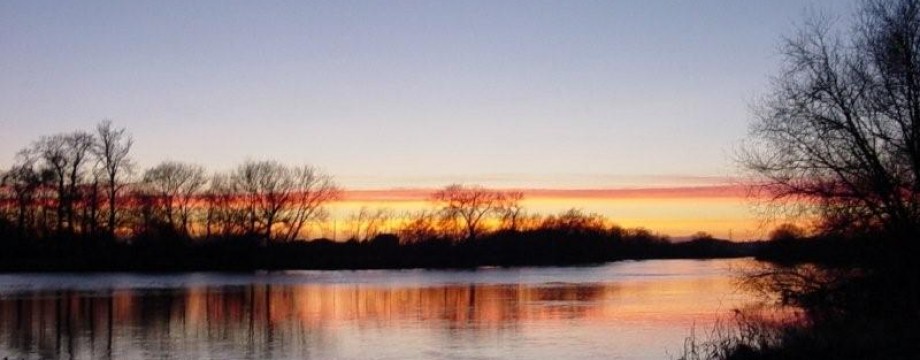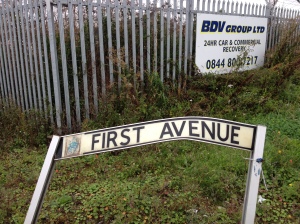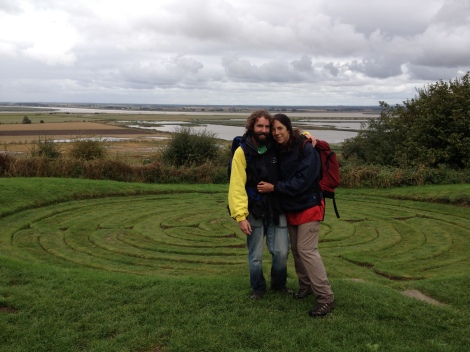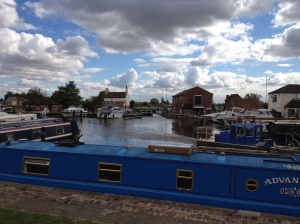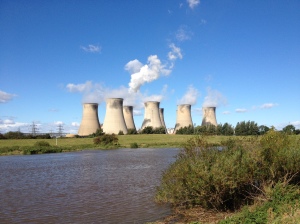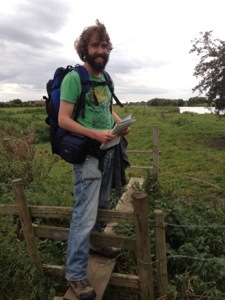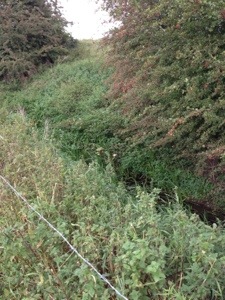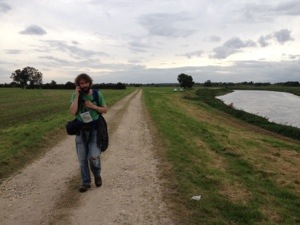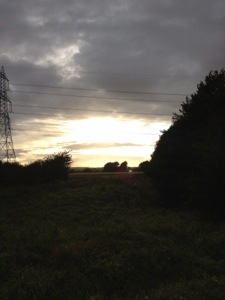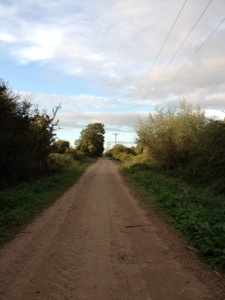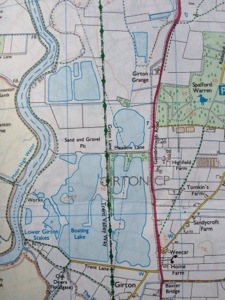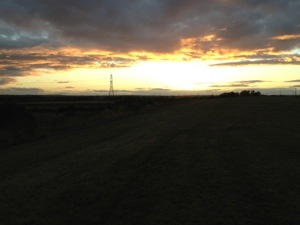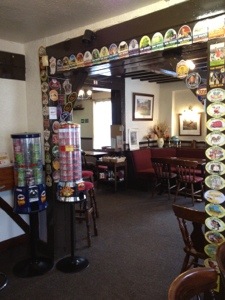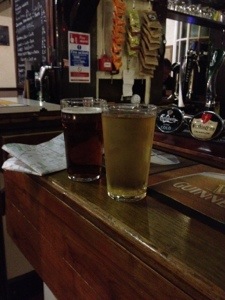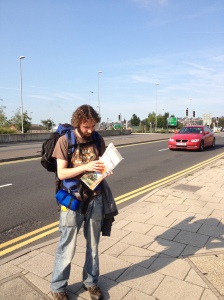Miles walked: 8.5
Weather: Rain, rain, rain until lunchtime. Then just clouds.
A journey like this is an odd thing. In a sense, you have a goal that you’re heading towards – the end of the river. But it’s not like you want to reach it. If what we wanted was to go to Trent Falls, we could have just got a bus there. What we wanted was to walk the river.
We’ve spent three weeks heading for Trent Falls, so there’s a sense of excitement at nearing our goal. But now it’s like the last day of your holiday. We’ve loved this adventure, we don’t want it to end. We feel conflicted.
I woke up early and Trent Falls immediately popped into my head. I knew I couldn’t get back to sleep, so I carefully slithered out to avoid waking Ross. Downstairs Sadie was fixing the kids’ breakfasts and they were all getting ready for school. In the rhythms of family life, it felt like a companionable little haven. I cranked up the laptop and tried to catch up with blogging.
Sadie and Rob got in touch with us through couch-surfer, where we’d posted a plea for hosts along our route. They’ve been following our progress all the way and been lovely and supportive. It was great to be somewhere people got what we were about and what we’re doing. It felt like they were part of it. But it did mean that every time I started a funny story, I’d suddenly realise half-way through that I’d put it on the blog and they’d probably read it. Normally people don’t have to know how recycled your funny lines are.
Rob was going to come and walk this last day’s stretch with us. Looking at the incessant rain, I felt kind of guilty we were dragging him out on what was clearly not going to be our best day’s walking.
We were also about to walk off the edge of our OS map – I was too stingy to buy the last one, cos it covered so little of the route. ‘How hard can it be to follow the river when it’s this big?’, I’d thought, from the comfort of home. Now I worried we were going to inflict our vagueness and ineptitude on a kind and blameless host. Ross says I worry too much about things. I call it consideration. After all, he thinks it’s OK to leave the toilet seat up in other people’s houses…
We agreed we’d set off walking at 10am from this side of Keadby Bridge, where Sadie had picked us up yesterday. It’s about 15 mins away by car, but Rob’s been reading our blog, he suggested we set off at 9.30am. Obviously we were ready about 9.45am, so we reached the car park by the bridge just in time.
A guy called Terry, who I knew from twitter, kindly came to meet us there and explained the best route to take. Terry’s a keen canoeist and environmentalist. He’s canoed the length of the Thames, the Severn and the Trent – the three largest rivers in Britain – and lives near the bank of the Trent just north of Scunthorpe. He canoes on the Trent as much as he can, picking up any litter he finds on his way. He told us he’s 61, but I’d have guessed 50. Keeping active and doing what you love is obviously good for you.
Armed with Terry’s directions and the last mile or so of Ordnance Survey map, we set off into the rain. There’s wharves along the east side of the river here, so we were walking a bit inland, along the road instead. Fast, but cheerless.
After a bit, the road bent back to the bank, and suddenly we found ourselves just a few yards from the river. We realised with a start that it was days since we’d been this close to the water. Since Holme on day 17, we’ve mainly been walking on flood defence embankments or roads, both set a little back from the Trent. Here the embankment was much lower than it’s been for days. We wondered what happens when the river’s in flood. But maybe, it being so wide here, it takes a shitload of water to raise the river even a foot or two.
We got as far as Flixborough Wharf, but ‘No entry without full safety equipment’ signs persuaded us to detour round that. 28 people were killed here in 1974 when a chemical plant exploded, safety-consciousness seemed pretty reasonable. The Flixborough explosion was something the audience yesterday at Scunthorpe Arts Centre talked about, obviously a significant event in local memory.
It happened on a Saturday when the plant was lightly staffed – if it had been a weekday, hundreds would have been killed.
Two months prior to the explosion, a crack was discovered in the number 5 reactor. It was decided to install a temporary 50 cm (20 inch) diameter pipe to bypass the leaking reactor to allow continued operation of the plant while repairs were made.
The temporary pipe ruptured. One woman said her aunt was a nurse at the time, and she remembers the bodies lying outside A&E, because there wasn’t enough room to deal with all the injured. Another woman remembers how everyone in Scunthorpe heard the explosion, but they weren’t sure if it was one of the steelworks or if it was the chemical plant. So many people had friends or relatives who worked at one or the other, they all headed out to try to find out what had happened. People were also all out for a Gala that day. The roads were chaos and the emergency services could only get to the site by screaming down the hard shoulder. She was just a kid, but remembers it vividly.
The wikipedia page makes sad reading, for the lack of safety-testing and expertise that lead to the explosion, and for the cover-up afterwards. 1,800 buildings within a mile of the site were damaged in the explosion. The 18 employees in the control room were killed instantly. The plant was rebuilt, in the teeth of local objections, but it closed down a few years later anyway. The price of nylon had dropped, so it didn’t make money any more.
We skirted the site, but then cut through yet another industrial estate, heading for a footpath disappearing tantalisingly off the edge of our map. It amuses me greatly the way industrial estates usually have numbered roads, that sound (pace New York), incongruously glamorous.
We wandered, unglamorously, round the industrial estate, having to backtrack a bit due to my mistaken map-reading, until we found our way out the other side. I felt guilty some more for us dragging patient Rob on our rainy perambulations. Once we were on the footpath we nominally sheltered under a railway bridge and ate a sandwich. No time for cups of tea today. We headed up the hill, past Burton Woods in the rain, and eventually found ourselves in Burton upon Stather. Another pretty but real little place we’d never have had occasion to visit if we weren’t following a river from one end to the other.
After some google mapping and guesswork, we headed through the churchyard and took a footpath that seemed to head along the ridge-top. Until google maps realises that you can walk along footpaths – or even seems to know they exist – it’s a complete joke them pretending to have walking directions. No, I’m not making a 5 mile detour along roads when there’s a footpath taking me exactly where I want to go. The footpath has been there for probably hundreds of years longer than the road, how come you don’t know about it? Call yourself a map?
It stopped raining about now, and we strode through the dripping woods, feeling like Robin Hood (well, I was, anyway) and rescinding our cynicism about the Met Office’s predictions. Terry, the canoe man, had driven up to Alkborough and walked back along the cliff top to meet us. He walked with us the last stretch.
Not long after we met Terry came a gap in the trees, and suddenly we could see Trent Falls ahead of us. It’s not a waterfall or anything, so I don’t really know why it’s called that. It’s just where the Trent joins the Ouse and forms the Humber Estuary. There isn’t actually a River Humber per se. No, I didn’t realise that either, before I started researching this. Bit of a swizz, eh? The Trent and the Ouse do all the hard work, and then the so-called Humber steals all the glory…
I’m not sure I can put into words how I felt. But obviously I’m going to give it a shot.
There was a real joy and a sense of excitement that the end was in sight. Being the closet romantic that I am, it felt mythical, like we were in an epic poem, or Lord of the Rings. Until now, we’d been just doing stuff, and however fun it was, it was just mundane, familiar stuff. Mainly, it must be said, walking and drinking tea. Suddenly I felt the urge to call up the elves, cast a spell, toss my raven-black hair* in the wind. I wanted an enchanted sword, and to start declaiming in cod-Olde English, ‘Stout companions, the end of our quest draws near and we fain must soon part ways!’
I probably read too many fantasy novels as a teenager.
We couldn’t quite believe we’d nearly done it. And we felt obscurely proud of the River Trent – our stout companion and trusty guide, these past few weeks. ‘We knew you when you were just a little trickle, and now, see how you’ve grown!’
Terry told us that just before the confluence, the Trent is about 3/4 of a mile across. In Stoke-on-Trent it’s a stream that wouldn’t come half-way up your wellies most days. At Biddulph Moor it’s little more than a muddy bit of a field. And look at it now.
We finally broke out of the woods and found ourselves by Julian’s Bower, with the confluence and Alkborough Flats wetlands below us.
This was our Plan A venue for the last event, but although it had stopped raining, it still seemed a bit too wet. Plan B was the Paddocks Tea Rooms (run, gloriously, by a woman called Mrs Ogg), so we headed round the corner to there.
Ross’s brother and his girlfriend had very kindly driven two hours down from York to see us do our last event. And Sadie had come to pick Rob up. It felt like a little get together. We ordered tea (of course), and Terry, to add to all his other kindnesses, treated us to bacon and egg butties. With all due respect to Bev Gibbs, I think this was the best bacon butty I’ve ever had.
We then began our last show. Quite a few people had come along to see us – mainly from the local WI and the local history group. But there were also a few people who’d just been in the tea rooms anyway, and some of them felt the need to carry on talking as loudly as possible throughout the show. Even though they were furthest away from us and could easily have talked to each other more quietly. To be fair, I suppose we were interrupting their dinner without asking.
There was also a toilet door just behind me that had a theatrically loud creak, an incredibly loud milk-frothing machine, and an unceasing crashing of crockery from the kitchen area. It was one of those spaces that’s all hard surfaces, with no soft furnishings to absorb sound, so it must always be really loud in there. Ross, sound engineer that he is, has been explaining the acoustic properties of different spaces to me as we’ve gone along.
However, after three weeks of this, having endured interruptions from dogs, dinners, engines, ice-crushing machines, locks, rain and parental offers of pork pie, I am unfazed by such things, and carried on regardless. Ross managed his bit with aplomb – for the last few days he’s been doing a story too, to help break things up a bit, now we don’t have Dad and his songs.
I could see he stumbled slightly over the fact that he was telling a story about him and his brother when they were kids, and that his brother was right there, and not expecting it. But Ross carried on like a trooper. The old ladies loved his story. It’s the twinkly eyes and mass of curly hair that gets them, I reckon.
They all shared their memories of the river afterwards, and said we were welcome in their village any time. High praise indeed!
Part of me wanted brass bands, champagne, the Mayor turning up and handing us bouquets of flowers. But this was appropriately mundane and tea-themed. Part of us still couldn’t believe we’d done it. Even now (I’m writing this five days later, due to, you know, sleep and stuff) it seems incredible.
We set off in Sam’s car up to Ross’s Mum’s house, feeling a mixture of emotions. Happy and contented, but sad it was over. We almost wanted to set off walking straight up the Ouse to York. After all, it was right there! As we drove, Ross and I were hatching plans for our next river…
*It’s brown actually, but if this were a fantasy novel, it would be raven-black. Also my breasts would be bigger. And I sure as hell wouldn’t be wearing baggy beige walking trousers.
